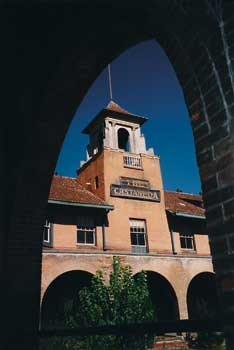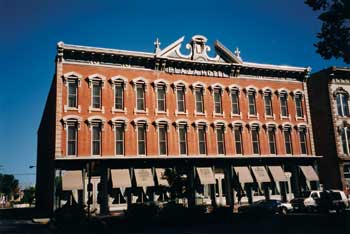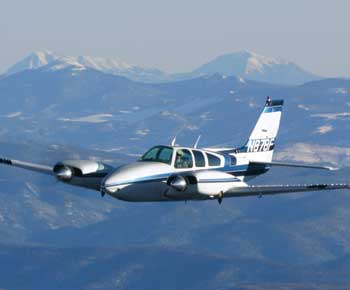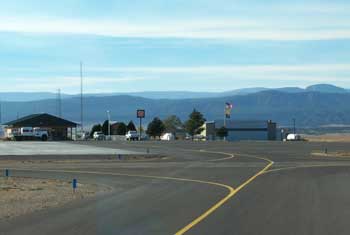|
|
 |
| SW Aviator Magazine is available in print free at FBOs and aviation-related businesses throughout the Southwest or by subscription. |

|
 |

|
 |
 |
 |
|
The web's most comprehensive database of Southwest area aviation events.
|

|
 |

|
 |
|
Featured Site:
|
|
|
 |
|
A continuosly changing collection of links to our favorite aviation related web sites.
|

|
 |

|
 |
 |
|

|
The First Las Vegas
|
|
Las Vegas is an exciting destination. It is a vibrant city filled with extraordinary architecture, unique hotels, and a wide variety of activities, both indoor and out. Las Vegas is also blessed with a fine airport, making it an easy weekend adventure despite its somewhat isolated location in the high plains of northern New Mexico.
That’s right, New Mexico. You didn’t think we were talking about that other Las Vegas, did you?
|
 By John M. Aragon and Gerrit Paulsen By John M. Aragon and Gerrit Paulsen
Located 65 miles east of Santa Fe, on the edge of the eastern plains and at the foot of the majestic Sangre de Cristo Mountains, Las Vegas, New Mexico has been a travel destination far longer than its glittering counterpart.
New Mexico’s Las Vegas was founded in 1835 by 29 Spanish settlers, who applied for and received the Las Vegas land grant from the Mexican government. The settlers laid out their fledgling town in the traditional Spanish manner, with a large central plaza anchoring the surrounding community.
This new self-sufficient farming village stood on the Santa Fe Trail, and was the first New Mexican settlement encountered by supply trains on their arduous 600-mile journey from the United States. The Trail meant jobs and commerce, and Las Vegas grew to over one thousand people by 1860. During the next 20 years, its population quadrupled as it established itself as a major trade center, with businesses as well as residences lining the plaza.
The arrival of the railroad in 1879 solidified the city’s position as a mercantile center. At its peak, Las Vegas’ trade area included all of eastern New Mexico and western Texas.
Even as Las Vegas prospered through 1905, its trade area was gradually reduced as additional rail lines crossed the territory. A local agricultural depression, followed by the depression of the 1930s, put an end to Las Vegas’ prosperity. A long period of economic dormancy followed, with the city being sustained by its two largest employers, the Las Vegas Medical Center and New Mexico Highlands University.
 The city’s long dormancy was boon to historic preservation, since it stopped development (and the inevitable accompanying demolition) dead in its tracks at the turn of the last century. This architectural jackpot is the reason many people visit Las Vegas today. There are over 900 structures in Las Vegas that are listed on the National Register of Historic Places. Self-guided walking tour pamphlets are available at many locations around town, including at the Las Vegas/San Miguel Chamber of Commerce at 513 6th Street (505-425-8631, lasvegasnm.org). The city is divided into nine unique historic districts, with the Plaza and the Railroad Districts being among the most visited. The city’s long dormancy was boon to historic preservation, since it stopped development (and the inevitable accompanying demolition) dead in its tracks at the turn of the last century. This architectural jackpot is the reason many people visit Las Vegas today. There are over 900 structures in Las Vegas that are listed on the National Register of Historic Places. Self-guided walking tour pamphlets are available at many locations around town, including at the Las Vegas/San Miguel Chamber of Commerce at 513 6th Street (505-425-8631, lasvegasnm.org). The city is divided into nine unique historic districts, with the Plaza and the Railroad Districts being among the most visited.
The Plaza and Bridge Street Historic District is where you will find shops and galleries, carrying antiques, furniture, paintings, art objects, clothing, weavings, and jewelry. Dominating the plaza is the historic Plaza Hotel. Built in 1882, it is considered by many to be the crown jewel of Las Vegas’ historic buildings. Lovingly restored and updated in 1982, the Plaza Hotel now boasts 36 guest rooms, each with private baths and generous dressing rooms. Rooms range from $79 to $108, with suites overlooking the plaza available for $138. Worthwhile discounts and specials can be found on their web site, plazahotel-nm.com (800-328-1882). Located adjacent to the hotel lobby is on of the best restaurants in town, Adelia’s Landmark Grill, which specializes in New Mexican food, steaks, pasta, and desserts (505-425-3591).
The Railroad Historic District is home to the La Castaneda Hotel. Built in 1898 to be a jewel in Fred Harvey’s famed chain of railroad hotels, La Castaneda is one of the early Harvey Houses to be built in the Mission Revival Style. Its main facade and courtyard face the railroad tracks. La Castaneda was a sister hotel to Albuquerque’s Alvarado Hotel, which was demolished in 1970. A visit to La Castaneda should include a walk through the hotel’s once grand lobby and dining room, both remarkably intact.
 Located a short drive west of Las Vegas, in the rugged and beautiful Sangre de Cristo Mountains, is the spectacular Montezuma Castle. Originally known as the Montezuma Hotel, the Castle was built in 1882 as a hot springs resort by the Atchison, Topeka & Santa Fe Railroad, along a spur line from Las Vegas. The Queen Anne Style hotel was the first building in New Mexico with electric lights. After a fire in 1884, the hotel was rebuilt, only to burn again in 1885. In 1886 the third and final Montezuma Castle opened. The resort hotel, with its proximity to the Montezuma Hot Springs, was a popular destination for travelers making the crossing from east to west and back. The 90,000-square-foot Castle housed a casino, an 11-lane bowling alley, stained glass from Europe, a Steinway piano, and a staff hired away from the best hotels in New York, Chicago, and St. Louis. Guests included Theodore Roosevelt, Rutherford B. Hayes, Ulysses S. Grant, William Tecumseh Sherman, Jesse James, and Emperor Hirohito of Japan. Located a short drive west of Las Vegas, in the rugged and beautiful Sangre de Cristo Mountains, is the spectacular Montezuma Castle. Originally known as the Montezuma Hotel, the Castle was built in 1882 as a hot springs resort by the Atchison, Topeka & Santa Fe Railroad, along a spur line from Las Vegas. The Queen Anne Style hotel was the first building in New Mexico with electric lights. After a fire in 1884, the hotel was rebuilt, only to burn again in 1885. In 1886 the third and final Montezuma Castle opened. The resort hotel, with its proximity to the Montezuma Hot Springs, was a popular destination for travelers making the crossing from east to west and back. The 90,000-square-foot Castle housed a casino, an 11-lane bowling alley, stained glass from Europe, a Steinway piano, and a staff hired away from the best hotels in New York, Chicago, and St. Louis. Guests included Theodore Roosevelt, Rutherford B. Hayes, Ulysses S. Grant, William Tecumseh Sherman, Jesse James, and Emperor Hirohito of Japan.
The Castle closed in 1903, and eventually fell into disrepair. In 1981 the Armand Hammer Foundation bought the property and located the American campus of the United World College there. In 2000-2001, the landmark underwent a $10.5 million renovation, transforming it into an international center with student and faculty housing, dining facilities, offices, and a student social center. Much of the building’s magnificent interior and exterior architectural and decorative features were restored and retained, including its stained-glass windows, and ornately carved ash ceilings and fireplaces. The interior of the Castle is only open to the public by guide tours, call 505-454-4221 for reservations or visit uwc-usa.org.
The history of the Santa Fe Trail is best seen at Fort Union National Monument, 28 miles northeast of Las Vegas. Established in 1851 to provided escort and protection for travelers on the west end of Santa Fe Trail, Fort Union grew to be the largest fort in the American Southwest, functioning as a military garrison, territorial arsenal, and military supply depot for the region. The National Monument has an interesting museum, and a 1.6-mile self-guided tour path that winds through the large, impressive ruins of the fort, and past the easily visible network of Santa Fe Trail ruts radiating from the complex.
Las Vegas is surrounded by recreation and wilderness, all within easy driving distance. The Las Vegas National Wildlife Refuge and MacAlister Lake are about ten miles from the city. Open seasonally, the refuge is a home to a variety of bids and wildlife. Storrie Lake, which is approximately four miles north of Las Vegas, offers sport fishing, boating, wind surfing, water skiing, and camping.
New Mexico’s clear, dark night skies are legendary among stargazers, so it’s no surprise that the first astronomy retreat in the country is located here. Opened in 1988, the Star Hill Inn is just ten miles north of Las Vegas, and caters to everyone interested in the heavens – amateur or professional. During the evening, guests can enjoy the New Mexico night skies through the Inn’s telescopes or their own, or enjoy a lively and entertaining telescope Star Tour with owner/astronomer, Phil Mahon. Accommodations at the Star Hill Inn are in private, comfortable guest houses. The recently redecorated guest houses range is size from studio to 3-bedroom, and each feature handcrafted furnishings, a covered porch, fireplace, kitchen, and private bath ($165 - $375, starhillinn.com, 505-425-5605).

Las Vegas is a great destination all year round. In the summer, the temperatures are comfortable, with highs typically in the lower 80s and cool evenings in the mid to lower 50s. If you visit during the summer monsoon season (July through September), you might be treated to an afternoon thundershower with a spectacular light show. During the winter months the high temperatures usually reach into the upper 40s, with teens at night. Average snowfall in town is 26.9 inches; most of which falls between December and March, but the surrounding mountains receive much, much more snow.
Las Vegas is convenient to three of the most popular ski areas in New Mexico: Ski Santa Fe, Sipapu, and Angel Fire. The closest is the Sipapu Ski and Summer Resort, approximately 53 miles north of Las Vegas. During the summer, the ski mountain is transformed into the Sipapu Disc Golf Course (disc golf is just like traditional golf, except you use a Frisbee). The course has been written up as “one of the top 5 scenic (disc) golf courses in the country, if not the world.” During the summer and fall there is an abundance of activities, including fly-fishing, horseback riding, hiking, biking, rafting, rock climbing, and arts and crafts fairs at this family-friendly resort. During the winter, the mountain changes back into a ski resort with four lifts serving 31 runs. One-day lift tickets range in price from $15 to $33. Sipapu also offers a variety of ski schools and classes for adults and children. A ski rental store is on location, along with a restaurant and gift shop.
The summer season also brings many festivals and special events to Las Vegas. The annual three-day Fourth of July Fiestas, which are held on the plaza, feature parades, the coronation of the Fiesta Queen, live music, and traditional food. The Fourth of July Fiestas started in 1850, less than four years after General Stephen Watts Kearney and his troops stood on the plaza and announced to stunned Las Vegas residents that they were no longer citizens of Mexico, but under the “protection” of the Army of the United States of America.
In Mid-August, the Citizens Committee for Historic Preservation shows off selected historic properties during its Places with a Past Tour. Guided tours are given by docents who talk about the architecture of the properties, and the people who lived there. Visit worldplaces.com/cchp or call 505-425-8803 for more information.
The Harvest Fair is held every September. The Harvest Fair, which is located in the Lincoln Park Historic District, includes a farmers market, a wide variety of arts and crafts vendors, and food booths from local restaurants. Local entertainers, including flamenco dancers and Spanish and western singers, provide the entertainment.
The Santa Fe Trail has now been replaced with Interstate 25 as Las Vegas’ main cross-country thoroughfare. Several modern motels and restaurants line the off-ramps, and there are many charming family-owned establishments in town. For a complete list visit the Las Vegas Chamber of Commerce web site at lasvegasnm.org, or call 505-425-8631.
Las Vegas, New Mexico’s ideal location in the Rocky Mountain foothills has brought it prosperity in the past, and brings visitors pleasure today. The wealth of historic buildings, a rich cultural heritage, and abundant scenic treasures are what set this first Las Vegas apart from all the rest.
 History History
By John M. Aragon
Aviation came to Las Vegas in 1927, when the Las Vegas Chamber of Commerce leased a 40-acre pasture, located about two miles outside of the city, to be used as an airfield. A local booster club, excited about the prospect of aviation in Las Vegas, painted a ‘Las Vegas’ sign on the hills east of the city. (Herbert Hoover, who was then Secretary of Commerce and an early aviation advocate, had recommended that cities paint their city name on the tallest building so that pilots would be able to recognize where they were from the air.) The booster club later added an arrow pointing to the landing strip, erected a wind direction indicator, marked the field with a circle, and placed gates at either end of the field to allow fuel trucks to enter.
Throughout the city, support for the airport was high. In October of 1928, the city received a letter from Transcontinental Air Transport (TAT), inquiring about the availability of landing fields near Las Vegas, since Las Vegas was being considered as a stop on TAT’s planned coast-to-coast route. This sent the city into a state of excitement, because TAT’s president was none other than Charles Lindbergh! On October 23, 1928 Charles Lindbergh came to Las Vegas to inspect the airfield. Thousands of residents came to the airfield to see Lindbergh, and his visit received extensive coverage in the newspaper, leaving a lasting impression on the residents of Las Vegas.
Unfortunately for Las Vegas, TAT eventually chose a different air route across New Mexico, with the stop being in Clovis. Las Vegas city officials were very disappointed, but some thought the city could still capitalize on the free publicity generated by the Lindberg visit to generate interest in building a new airport. For the next 10 years there were many attempts to build an airport. Then, in 1939, the city finally received the funding from the Civil Aviation Authority (CAA), and the support they needed to build the airport.
The first major construction at the Las Vegas Municipal Airport began on April 1, 1941 under the supervision of the Army Corp of Engineers. The City of Las Vegas formally received the airport from the CAA on July 24, 1942. Additional facilities that were built at the airport included a CAA communications station, a rotating beacon, a small brick building for Continental Air Lines, and a hangar for New Mexico Highlands University.
During World War II, the Navy used the airfield for pilot training, and the New Mexico National Guard has also used the airfield for training. New Mexico Highlands University used its hangar as a classroom and workshop, training aircraft mechanics for defense work. After World War II the aircraft mechanics program branched out, with the university offering a two-year airport operators’ course, until government support for the program ended after the Korean War.
In the past two years, the Federal Aviation Administration, the New Mexico Department of Transportation Aviation Division, and the City of Las Vegas have spent close to $4 million on improvements at the airport. Traffic is picking up, and the entire community is again rallying around the airport.
The recent airport improvement projects have included the widening and overlay of runway 14-32 and its parallel taxiway, reconstruction of the entire ramp, and construction of a new helipad. The newly reconstructed ramp has plenty of tiedowns, and a concrete heavy aircraft apron.
Upcoming projects planned for the airport include an overlay of runway 2-20. Once this overlay is completed, all of the pavement at the airport will be either new or rehabilitated. There will also be some improvements around the terminal building. There are plans to install lighting (MIRL), a visual guidance system (VASI), and guidance signs on runway 2-20. There are also plans to add a 1000’ extension on Runway 2-20.
There are a lot of things happening at and around the Las Vegas Municipal Airport. Whether it’s for the weekend or just a refueling stop, fly in and see us at Las Vegas.
|
Las Vegas Municipal Airport
If you haven’t flown into the Las Vegas, New Mexico Municipal Airport for a while, come see all the enhancements. The airport is attended seven days a week, 0800 to 1700. After hours, call the pager at 505-425-4866 or call the police department at 505-425-7504. Rental cars can be delivered to the airport with advance notice, call the airport at 505-454-0881 for the phone numbers of participating rental car companies.
The elevation at the airport is 6877 feet. Las Vegas Municipal Airport has published VOR approaches on runways 2 and 20. There are GPS approaches on runways 2, 20, and 32. Weather data can be obtained from ASOS (118.525) and HIWAS (117.3). The Unicom frequency is 122.8.
Even if you can’t stay and enjoy the attractions, the Las Vegas Municipal Airport is still a great place to stop for fuel. They offer a quick turn-around time and low prices on both 100LL and Jet A.
The Las Vegas Municipal Airport is home to a Single Engine Air Tanker (SEAT) base. During fire season, this unit assists the fire crews in northern New Mexico. One of the SEATs based at the airport is an 802-Air Tractor, owned and operated by Aero Tech, Inc., a nationally known firm located in Clovis, New Mexico. The SEATs are contracted through the New Mexico State Forestry, and supported by the Las Vegas Fire Department, the City of Las Vegas, and the Public Works Department.
|
|
John M. Aragon is the Las Vegas Municipal Airport manager, a position he has held for the past four years. He was born in Las Vegas, NM, and has lived in nearby Mora his whole life. A graduate of Luna Community Collage, John is an active member of the Airport Manager association, and is a volunteer fire fighter for the LMC fire department as well as a wild land fire fighter for the New Mexico State Forestry.
|
Click here to return to the beginning of this article.  |
|